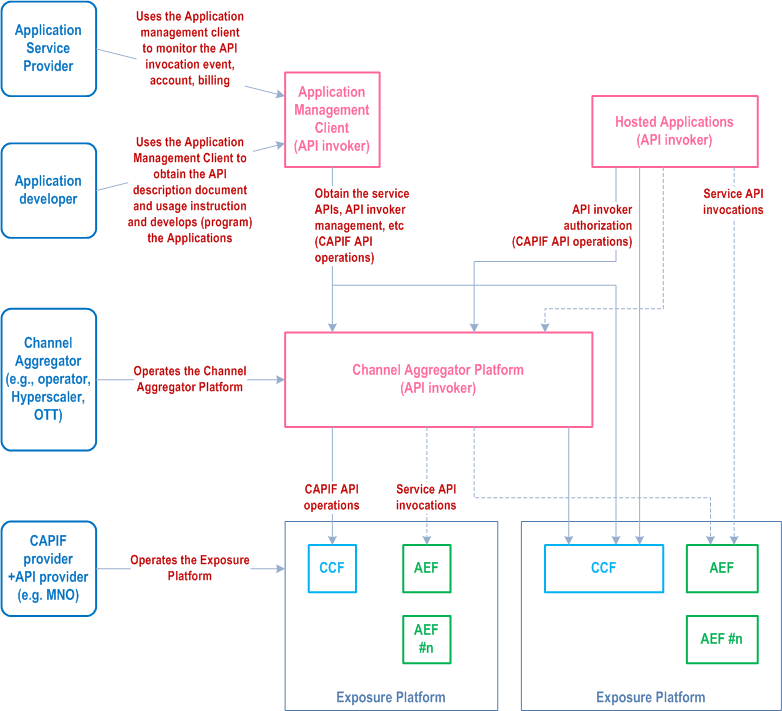Content for TS 23.222 Word version: 19.3.0
0…
4…
5…
6…
6.3…
6.4…
7…
8…
8.5…
8.8…
8.9…
8.13…
8.17…
8.21…
8.25…
8.26…
8.28…
8.30…
9…
10…
10.4…
10.7…
11…
A
B…
B.2…
B.3…
C…
D…
D CAPIF relationship with external API frameworks
E Configuration data for CAPIF
F Examples of API invoker roles in CAPIF
$ Change history
D CAPIF relationship with external API frameworks p. 130
This Annex provides the relationship of CAPIF with the OMA Network APIs and the ETSI MEC API framework. The relationship of CAPIF with these external API frameworks is illustrated in the Table D-1. "Yes" means that the external API framework supports the CAPIF functionality, "No" means that the API framework does not support the CAPIF functionality, and "Partial" means that it provides a mechanism that partially supports the CAPIF functionality.
| CAPIF functionalities | OMA Network APIs | ETSI MEC API framework | ||
|---|---|---|---|---|
| Supported | Reference | Supported | Reference | |
| Publish and discover service API information | Partial
(see NOTE) |
OMA-TS-NGSI_ | Yes | ETSI GS MEC 011 [7] |
| Topology hiding of the service | Yes | Individual API exposing function | Yes | Individual API exposing function |
| API invoker authentication to access service APIs | Partial |
OMA-ER_ | Partial | ETSI GS MEC 009 [8] |
| API invoker authorization to access service APIs | Partial |
OMA-ER_ | Partial | ETSI GS MEC 009 [8] |
| Charging on invocation of service APIs | No | No | ||
| Lifecycle management of service APIs | No | No | ||
| Monitoring service API invocations | No | No | ||
| Logging API invoker onboarding and service API invocations | No | No | ||
| Auditing service API invocations | No | No | ||
| Onboarding API invoker to CAPIF | No | No | ||
| CAPIF authentication of API invokers | No | No | ||
| Service API access control | Partial |
OMA-ER_ | Partial | ETSI GS MEC 009 [8] |
| Secure API communication | Yes |
OMA-ER_ | Yes | ETSI GS MEC 009 [8] |
| Policy configuration | No | No | ||
| API protocol stack model | Partial |
for REST: OMA-TS_ | Partial | for REST: ETSI GS MEC 009 [8] |
| API security protocol | Partial |
OMA-ER_ | Partial | ETSI GS MEC 009 [8] |
| CAPIF support for service APIs from multiple providers | No | No | ||
|
NOTE:
OMA-TS-NGSI_
|
||||
E (Normative) Configuration data for CAPIF p. 131
The configuration data is stored in the CAPIF core function and provided by the CAPIF administrator.
The configuration data for CAPIF is specified in Table E-1.
| Reference | Parameter description | ||||||||
|---|---|---|---|---|---|---|---|---|---|
| Subclause 4.2.2 | List of published service API discovery restrictions | ||||||||
| > Service API identification | |||||||||
| > API invoker identity information | |||||||||
| Subclause 4.7.2 | List of service API log storage durations | ||||||||
| > Service API identification | |||||||||
| > Service API log storage duration (in hours) (see NOTE) | |||||||||
| Subclause 4.7.4 | List of API invoker interactions log storage durations | ||||||||
| > Service API identification | |||||||||
| API invoker interactions log storage duration (in hours) (see NOTE) | |||||||||
| Subclause 4.10 | List of access control policy per API invoker and optionally per network slice | ||||||||
| > Volume limit on service API invocations (total number of invocations allowed) | |||||||||
| > Time limit on service API invocations (The time range of the day during which the service API invocations are allowed) | |||||||||
| > Rate limit on service API invocations (allowed service API invocations per second) | |||||||||
| > Service API identification | |||||||||
| > API invoker identity information | |||||||||
| > Network Slice Info | |||||||||
|
NOTE:
If no value is set for the duration, the duration is assumed to be unlimited.
|
|||||||||
F Examples of API invoker roles in CAPIF |R19| p. 131
The Figure F-1 provides examples of API invoker roles in CAPIF and illustrates the usage of CAPIF capabilities.
The following examples of API invoker roles are illustrated:
- Application management client: The application developers utilize the CAPIF APIs using an Application management client as an API invoker to obtain the service APIs information to implement the application program. Such application programs are hosted on cloud, edge or on a UE.
- Hosted applications: The Hosted applications (which are programmed to utilize the service APIs) as an API invoker invoke the CAPIF APIs and service APIs as per the application business logic.
- Channel Aggregator Platform: The Channel Aggregator aggregates the APIs from one or more southbound CAPIF providers with the intention to re-expose such APIs or expose value-added APIs developed using the APIs from the southbound CAPIF providers to the northbound side Application management client or Hosted applications. The Channel Aggregator Platform as API invoker invokes the CAPIF APIs and service APIs as per its business logic.
